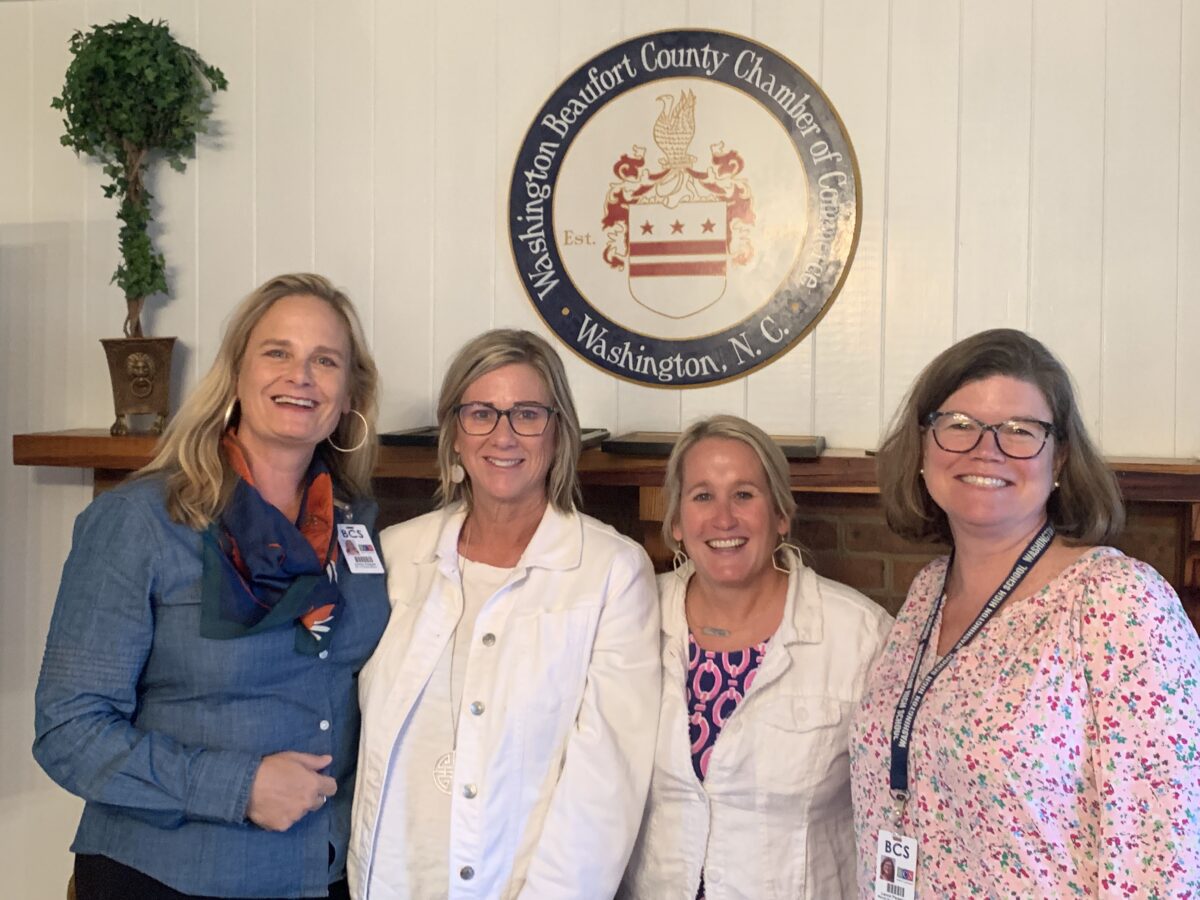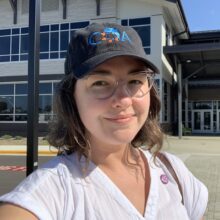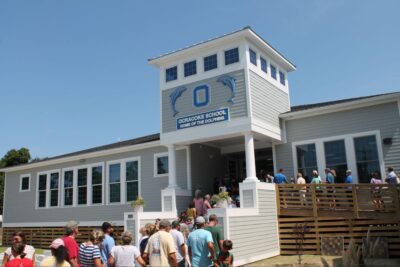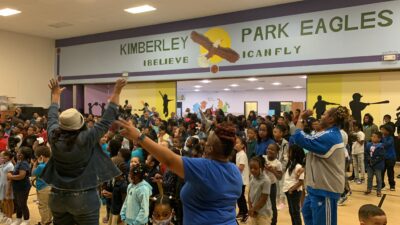

|
|
For almost 10 years, the Washington-Beaufort County Chamber of Commerce and Beaufort County Schools (BCS) have worked together to meet the basic needs of public school students in Beaufort County.
Those needs vary widely, but the support of Bright Futures Beaufort County remains steadfast.
“I mean we do everything from shoes, to A/C units for homes, to graduation gowns, washers and dryers, lots of beds,” said Robin McKeithan, assistant director of the Chamber and coordinator of Bright Futures Beaufort County.
To do all of that, Bright Futures brings together resources from the business community, support from religious and civic groups, donations of goods and services from individual volunteers, and grants from philanthropists.
‘Bright Futures miracles’
The work of Bright Futures Beaufort County begins inside the public schools.
In a typical school district, teachers and other staff members often rely on their own financial resources to provide their students with basic necessities.
“You know as a teacher, if a kid needs deodorant, you just go bring it,” said Ashley Padgett, who works with Bright Futures as director of Project AWARE for BCS.
But Bright Futures tells those teachers, “If a kid needs shoes, let someone else have the joy of giving them shoes. You get the joy of hanging out with them!” Padgett said.
Any staff member (teachers, counselors, bus drivers, nutritionists, administrators, etc.) can fill out a simple needs request form to help students through Bright Futures.
The form requires only basic information: the name and grade level of the student, size of their family, items needed, issues contributing to the need, and “any avenues already pursued to meet the need.”
The form is shared with McKeithan, who aims to make a plan for meeting the need within 24 hours.
Sometimes that means reaching out directly to local businesses for in-kind donations of goods or services. More often it means posting a request for specific goods or services to Bright Futures’ Facebook and Instagram pages, where members of the community can volunteer to donate.






McKeithan then coordinates with her counterparts in BCS to get the donated goods or services to the student in need.
For several years, those counterparts have been Padgett and Laurel Paramore, the district’s mental health coordinator.
Both women are preparing to retire, but they do so knowing they’ve had a positive impact on the lives of BCS students and their community.
“There’s all kinds of stories,” Paramore said. “We call them Bright Futures miracles.”
She shared one recent example from a presentation she gave to the Chamber’s Washington Young Professionals Network. After she explained the mission of Bright Futures Beaufort County to the group — all of them ages 21 to 35 — one asked her: “What do you need right now?”
Paramore recalled saying, “Well, this family just moved into this trailer, and it’s 100 degrees out with no air conditioning.”
A listener said they had a window unit in storage that they’d be more than happy to donate. Paramore worked quickly to get the air conditioner to the family.
And that’s just one type of “miracle.”
From Padgett’s perspective, Bright Futures does more than meet the basic needs of impoverished students — it helps protect the paychecks of teachers, counselors, and other school staff “who don’t make enough money either.”
Taking the burden from schools
In addition to meeting the immediate individual needs of students and their families, Bright Futures Beaufort County also has a system in place for supporting schools and their staff members.
Ten of the district’s 13 schools have “site councils” in place to handle schoolwide requests.
Those councils are made up of people from businesses, churches, nonprofits, and parent groups — “community members who care about that school,” as Catherine Glover, executive director of the Washington-Beaufort County Chamber of Commerce, puts it.
When McKeithan helps a school start a site council, she starts with a question: What are your top needs?
“It might be a food pantry, and there might be a church or businesses that we want to fund that. They might want landscaping or walls painted, and there might be another group, or a couple of groups, that say, ‘well, we can do the painting,’ ‘we can donate the money for the painting.’ So if you’re all sitting around the table, you can figure out who wants to do what. And different organizations want to do different things — it may be volunteering, it may be writing a check.”
Robin McKeithan, coordinator of Bright Futures Beaufort County
Glover serves on the site council of her son’s high school.
“We sat around the table and all the counselors were like, ‘We need 280 binders for all the juniors coming up,’” Glover said. “United Bank is sitting there and the bank’s like, ‘oh we’re going digital, we’ll give you all the binders from all of our offices across all of eastern North Carolina,’ and the next thing we know 280 binders roll in.”
That’s why McKeithan says, “The more people that sit around the table and work together, the better.”
In another example, an elementary school had everything it needed to set up a “calming room” — a place for young students to go when they need a safe, supervised space to manage big feelings that might otherwise get them in trouble.
But the school’s counseling team was short-staffed, and didn’t have time to set up the room on top of all their regular responsibilities.
The school’s Bright Futures site council heard about the challenge, and the next day its members set up the room.
“It takes a huge burden off of the schools who don’t have time to do, quote unquote, extra — they’re doing that all the time,” Paramore said.
Sometimes students’ needs are so great, that they require both the immediate relief that McKeithan coordinates, along with support from their school’s site council.
Padgett described a circumstance in which a senior at one of the high schools was racking up absences. His parents were sick at home, and he and his sister — who was attending nursing school — were considering leaving school to care for them.
After connecting with the family, Padgett and Paramore realized that the biggest barrier between the students and school was their inability to prepare hot, healthy meals for their parents each night.
“A hot meal a day,” Padgett said. “That was gonna keep a girl from graduating as a nurse and a boy from graduating high school.”
Padgett and Paramore described the situation to Glover and McKeithan, who contacted a caterer who was a member of the Chamber. Together they came up with an estimate of what it would cost the caterer to provide a healthy, family-style hot meal each day for several weeks while the parents returned to health.
Bright Futures posted the amount needed on social media and quickly raised the necessary funds. But that left the challenge of getting the food from the caterer to the home each day.
That’s where the high school’s site council stepped in. Its members signed up to help with deliveries.
Both students stayed in school.
Not just a ‘feel good’ program
The idea for Bright Futures Beaufort County came from a business member of the Chamber of Commerce back in 2014.
PotashCorp (now Nutrien) operated the phosphate mine in Aurora, on the southern end of Beaufort County. One of the company’s processing facilities was in Joplin, Missouri, where the first Bright Futures program was established.
Nurtien brought in a team from Bright Futures USA to introduce the program at a meeting in the school district’s central office. Under their national framework, school districts typically manage the program.
Glover and McKeithan were two of about 20 people in the room that day who were charged with starting Bright Futures Beaufort County.
“And we said, ‘What if we do this in a whole different capacity than what has ever been done before?’” Glover said.
Glover’s background in economic development and business growth inspired her to imagine a version of Bright Futures managed by the Chamber of Commerce, instead of the overburdened school district.
“Our future workforce is sitting in Beaufort County Schools,” Glover said. “But if their basic needs are not met, how do we expect a student to be a productive citizen and give back to the community and be employable?”
The school district supported this innovative approach to building Bright Futures Beaufort County, but the connection between meeting students’ basic needs and supporting the local business community wasn’t immediately obvious to everyone.
“A lot of people were like, ‘Eh, this is feel-good,’” Glover said. “And I’m like, it’s not ‘feel-good’ — this is grassroots workforce development.”
Glover’s argument persuaded the Board to house Bright Futures in the Chamber of Commerce office, establishing it under their nonprofit foundation. McKeithan spends half of her time as assistant director managing the program.
That means the overhead for Bright Futures’ office and half of McKeithan’s salary is covered by the Chamber, but the rest of the $50,000 needed to operate the program each year comes from grants.
Fortunately, McKeithan and Glover had some reliable funders when the program started.
Bright Futures Beaufort County received $20,000 annually from Nutrien for the first three years, and from the Louise R. Lester Foundation the next three years. Both organizations have continued to give in the years since, but in smaller amounts.
Now grant-writing is a major element of McKeithan’s work — on top of fielding need requests, connecting with families, soliciting in-kind donations, and coordinating deliveries.
“This could be a full-time role all day long,” Glover said.
Essential to the program’s success is a longstanding memorandum of understanding (or MOU) with Beaufort County Schools that has enabled them to effectively collaborate.
“This would not work if the school wasn’t behind it,” Glover said. “And the schools, the central office, and everybody in the schools is so supportive of it. And the Chamber is so supportive of them that the relationship works.”
Padgett and Paramore have been at the heart of that relationship.
“These two are retiring, which is really stressing us out,” Glover said. “These two really get it, and they’re the reason that the program has grown over the past couple of years.”
McKeithan concedes that even she didn’t fully “get it” when she took on the role as coordinator of Bright Futures.
“My two children grew up in Beaufort County Schools. I was a very involved mom. I was at the schools all the time,” McKeithan said. “Until we started Bright Futures, I didn’t know the need was there.”
Author’s note: Padgett’s and Paramore’s last day before retirement is September 29, 2023. They both plan to return to Bright Futures Beaufort County as volunteers.





